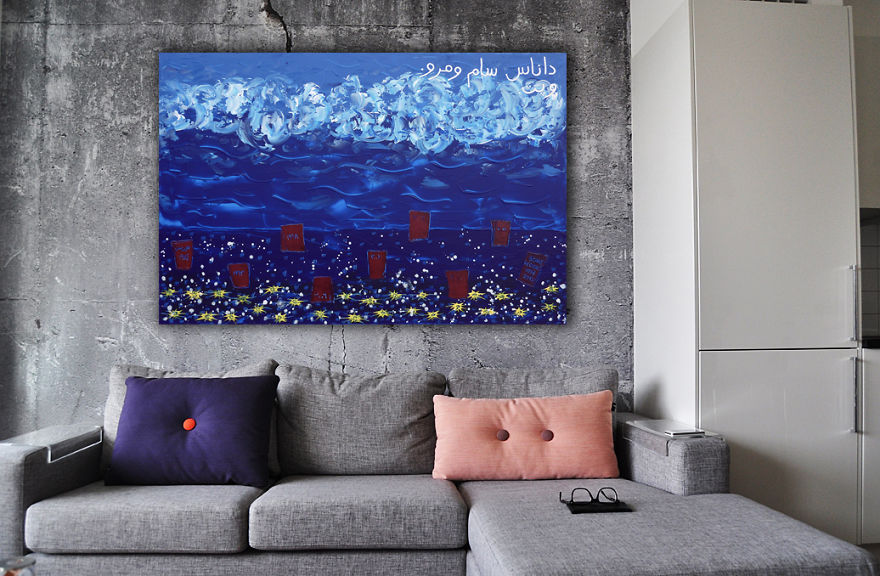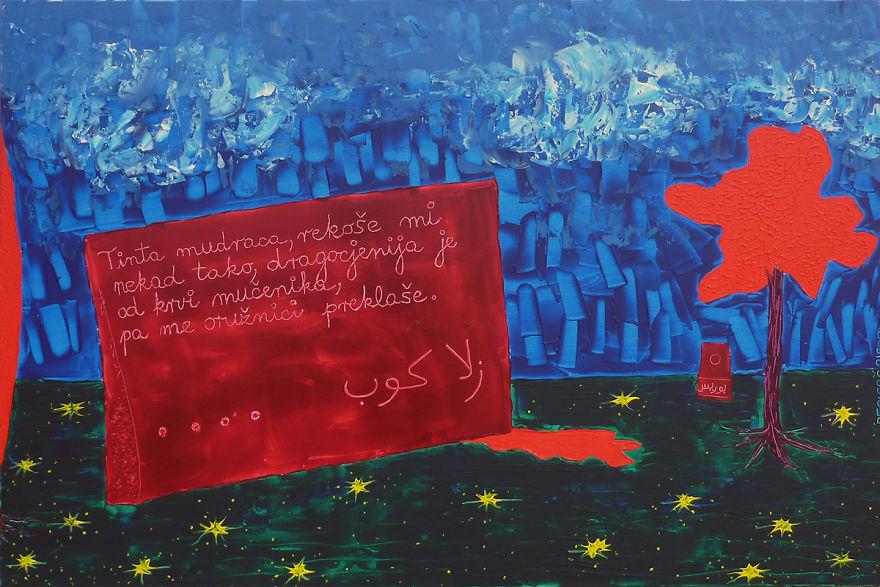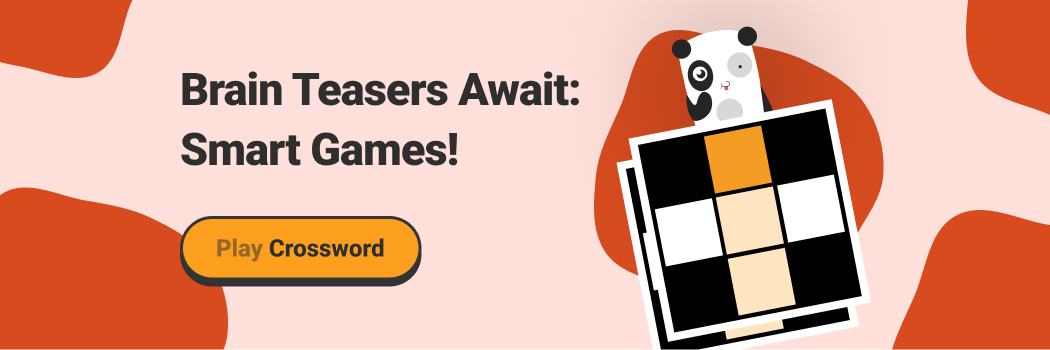It was hot sunny August 2013 when I died. Yes, I died… for the ninth time.
The first time I died was when I was born. I died to oblivion before my birth, or… to spiritual life before birth, if it even existed, I don’t know for sure. After that first death I died several times more, every time when very big and unpleasant change happened in my life. Last time it was in 2013. Ten paintings are left as a witness to that.
Actually, nothing happend then, but my life was so unsatisfying, so empty, so failed… that I really wanted to die. So, I started to paint this series of ten paintings in which I burried myself. It was somewhat prophetic – because, that was the very last year I lived in Zagreb, Croatian capital. Soon, opportunity came to move to another city at the Adriatic coast; I fell in love, I get a great artistic project in a nature park, and my new life was born. So, I learned how good is to die!
I had an inspiration for that painting series in ancient Azerbaijani stelae and epitaphs written on them. I named the whole series “Post mortem”. Azerbaijani epitaphs on tombstones are from the 16th and 17th century.
So, what did the ancient people leave carved on stone stelae of distant Caucasus!? What kind of thoughts they were preoccupied with in encounter with transience and death!? How do these thoughts resonate in verses of contemporary poets who have not denied the mortality nor turned their head at the mere mention of finality of existence!? And how did I artistically interprete this eternal taboo?
In ten scenes I deal with my own mortality and the fear of it, with issues of meaning(lessness) of existence, and by the way I nicely buried some of my lifeless and already half-decomposed corpses of beliefs. So, you will notice my name on some of the tombstones.
More info: boris-pecigos.com
1. Hey, turn around!
It is written on the painting:
“Hey, turn around!
I am in eternity.
You temporary.”
(Epitaph on the Azerbaijani stela from 16th/17th century)
Language of the painting’s inscription is Croatian, and script is Arabic and/or Latin.
2. Why am I here?
It is written on the painting:
“I came to this world, and has it got anything by that?
I’ll leave, and will that change anything?
Oh, if one could now say, why am I here,
I, who have come from dust and to dust I return.”
(Epitaph on the Azerbaijani stela from 16th/17th century)
Language of the painting’s inscription is Croatian, and script is Arabic and/or Latin.
3. To a Passerby
It is written on the painting:
“Passersby, do not boast you’re alive.
You’re still on the road, I’m already home.”
(Epitaph on the Azerbaijani stela from 16th/17th century)
Language of the painting’s inscription is Croatian, and script is Arabic and/or Latin.
4. Today I died
It is written on the painting:
“Today I died.
Again.”
(Verses from the poem “Today I died” written by Boris Pecigoš (1974 – 20__))
Language of the painting’s inscription is Croatian, and script is Arabic and/or Latin.
5. Ill Fate
It is written on the painting:
“The ink of sage, once I was told that, is more precious than the blood of the martyrs, so gendarmes slaughtered me.”
(Epitaph on the Azerbaijani stela from 16th/17th century)
Language of the painting’s inscription is Croatian, and script is Arabic and/or Latin.
6. The Lucky Ones
It is written on the painting:
“How lucky you are, you who carelessly pass by us, you are blessed! You are not exposed to gossip, hostility and mutual quarrels.”
(Epitaph on the Azerbaijani stela from 16th/17th century)
Language of the painting’s inscription is Croatian, and script is Arabic and/or Latin.
7. Procession
It is written on the painting:
“Until the last moment
unconscious they are
when they finally realize
stunned
that the grave awaits just for them
for everyone from that eternal procession
of grotesque characters.”
(Verses from the poem “Procession” written by Boris Pecigoš (1974 – 20__))
Language of the painting’s inscription is Croatian, and script is Arabic and/or Latin.
8. When a man dies…
It is written on the painting:
“When a man dies, bury him anywhere, preferably under a tree, flatten the ground and forget him as soon as you can.”
(unknown, folk saying)
Language of the painting’s inscription is Croatian, and script is Arabic and/or Latin.
9. Why the pain, sob and cry!?
It is written on the painting:
“Why the pain, sob and cry?
We should become overwhelmed with joy
for every death that comes,
for those souls lucky
that out of this hell in the path of light they move!?”
(Verses from the poem “I’m not ready to die” written by Boris Pecigoš (1974 – 20__))
Language of the painting’s inscription is Croatian, and script is Arabic and/or Latin.
10. Post mortem
It is written on the painting:
“I died in the hope that death will bring me something new
Magic was gone, it went into some sort of huge emptiness
Oh, how don’t you know now the song famous and beautiful
About a piece of heaven, and bundle of branches, about feather
That what we were accustomed to was to live
Now about this world there’s no voice
Nobody seeks us, nor asks for us
It’s so dark, dark my night
Anyway, is there any windows
When in the water there is no my reflection”
(Verses from the poem “Post mortem” written by Cahit Sıtkı Tarancı (1910 – 1956))
Language of the painting’s inscription is Croatian, and script is Arabic and/or Latin.
All ten Post mortem paintings
At the exhibiton
111views
Share on Facebook
 Dark Mode
Dark Mode 

 No fees, cancel anytime
No fees, cancel anytime 















































6
0